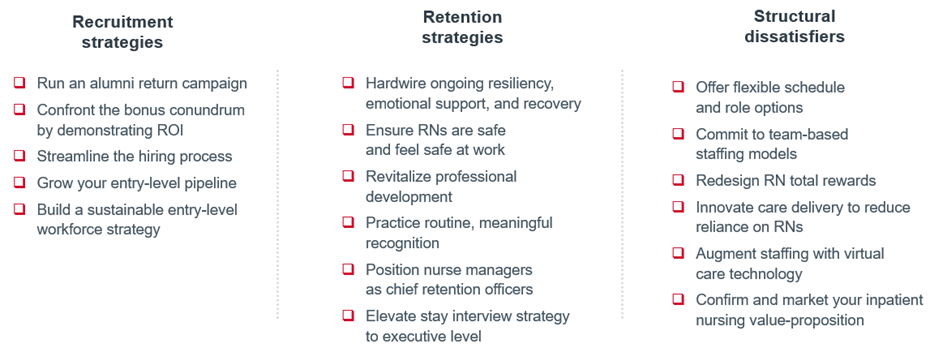Auto logout in seconds.
Continue Logout
As Covid-19 stabilizes, will the nursing shortage subside?
I'm here to tell you the hard and fast truth: it won't. The longer we fail to acknowledge this reality, the more difficult it will be to address—both from an individual health system perspective and from the larger national level. If I've learned one thing from my countless conversations with executives over the past year, it is that we should be prepared for the long haul.
The severe workforce shortages impacting health systems around the country are not subsiding anytime soon. This is a different in-kind shortage that will require different in-kind solutions engaged by the C-suite. According to a national survey, the current top three hospital CEO priorities are quality of care & patient safety, retaining talent or employee turnover, and registered nurse/professional recruitment. But many C-suite leaders believe that staffing instability will dissipate as Covid-19 volumes decrease. We firmly believe that staffing instability will not go away with Covid-19.
So how do we manage our immediate staffing crisis while also working to reverse the shortage in the long run? There are both near- and long-term tactics to employ, but first it is necessary to acknowledge some hard truths and consider how we got here in the first place.
The 6 hard (but important) truths about the nursing workforce
Akin Demehin, director of policy for AHA, summarized the situation well: "2020 was the year of, 'Everyone to the barricades—let's solve this national problem.' And 2021 is the year of 'If this is what it's going to be live, I've got to reevaluate my life." The same message should ring loud and true for C-suites addressing the nurse staffing crisis. This is a strategic health system challenge and as such requires the commitment of the entire C-suite.
To prepare for the future of the nursing workforce, all C-suite leaders will need to accept six hard truths:
- Waning organizational loyalty has eroded bedside RN longevity.
- Staff need work-life balance. Without it, they will not stay with you.
- Care models that rely disproportionately on RNs are no longer sustainable.
- Assistive personnel can't be overlooked anymore—they are critical to team-based care.
- Overreliance on contract labor is unsustainable.
- Staffing is a zero-sum game, and everyone is your competitor for nursing talent.
With each hard truth outlined above, there are critical details and guiding principles to follow. We've carried out extensive research and countless conversations to unveil the most important facets of these hard truths.
Beyond the tipping point—how did we get here?
Last Friday, Kentucky announced a state of emergency relating to the nursing shortage to help bolster the number of nurses graduating from their schools as well as other immediate retention strategies. The Michigan State Medical Society also just called for emergent solutions. This comes three months after the American Nurses Association urged HHS to declare nurse staffing shortage a national crisis. The message is clear: we are beyond the tipping point.
Some may wonder whether the shortage we are experiencing today is similar to other cyclical shortages we have seen over the years—ones that subside and pass with patients and diligent hiring. Our take on that assumption is no.
What we are seeing now is a different shortage for a few underlying reasons. For example, there are structural issues with the complexities of the inpatient practice environment that could not be addressed during various heights of Covid-19. Beyond this challenge, we now have an incredibly battered workforce, accelerated retirements above any typical rates, and employees who are voicing entirely new sets of work-life expectations.
Double down on recruitment and retention strategies—and stick to them.
Beyond long-term strategies, there are still near-term tactics that can help advance staffing and stabilization efforts in the here and now. These tactics will help leaders address current pipeline problems, retention pain points, and structural barriers to nursing practice that push nurses out of hospital-based practice. We've outlined some of these in the below graphic:

And while it's absolutely necessary to stabilize the nursing workforce immediately, C-suite leaders need to be fully aware of band-aid solutions, such as lucrative sign-on bonuses and the long-term reliance on travel nurses. While these tactics are necessary in several market, we urge caution to over rely on these tactics because they will do little to stabilize the nursing workforce in the long-term, which should be the ultimate ambition.
Nadia Critchley contributed to this article.
Don't miss out on the latest Advisory Board insights
Create your free account to access 1 resource, including the latest research and webinars.
Want access without creating an account?
You have 1 free members-only resource remaining this month.
1 free members-only resources remaining
1 free members-only resources remaining
You've reached your limit of free insights
Become a member to access all of Advisory Board's resources, events, and experts
Never miss out on the latest innovative health care content tailored to you.
Benefits include:
You've reached your limit of free insights
Become a member to access all of Advisory Board's resources, events, and experts
Never miss out on the latest innovative health care content tailored to you.
Benefits include:
This content is available through your Curated Research partnership with Advisory Board. Click on ‘view this resource’ to read the full piece
Email ask@advisory.com to learn more
Click on ‘Become a Member’ to learn about the benefits of a Full-Access partnership with Advisory Board
Never miss out on the latest innovative health care content tailored to you.
Benefits Include:
This is for members only. Learn more.
Click on ‘Become a Member’ to learn about the benefits of a Full-Access partnership with Advisory Board
Never miss out on the latest innovative health care content tailored to you.

